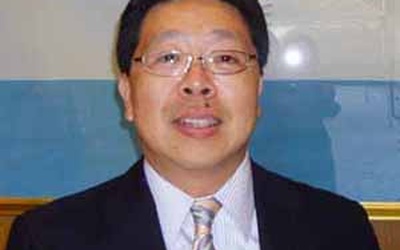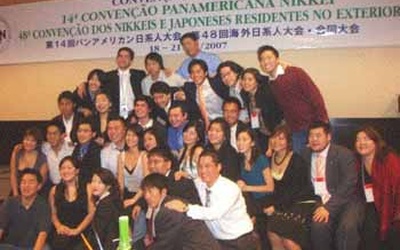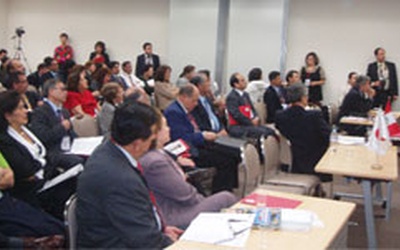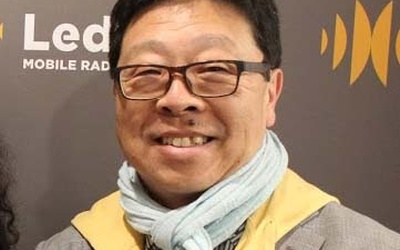
Alberto J. Matsumoto
@albertomatsumotoNisei Japanese-Argentine. In 1990, he came to Japan as a government-financed international student. He received a Master’s degree in Law from the Yokohama National University. In 1997, he established a translation company specialized in public relations and legal work. He was a court interpreter in district courts and family courts in Yokohama and Tokyo. He also works as a broadcast interpreter at NHK. He teaches the history of Japanese immigrants and the educational system in Japan to Nikkei trainees at JICA (Japan International Cooperation Agency). He also teaches Spanish at the University of Shizuoka and social economics and laws in Latin America at the Department of law at Dokkyo University. He gives lectures on multi-culturalism for foreign advisors. He has published books in Spanish on the themes of income tax and resident status. In Japanese, he has published “54 Chapters to Learn About Argentine” (Akashi Shoten), “Learn How to Speak Spanish in 30 Days” (Natsumesha) and others. http://www.ideamatsu.com
Updated June 2013
Stories from This Author
ラティーノ日系人の祖国、故郷、居住国、出身国
April 10, 2008 • Alberto J. Matsumoto
移民すると、いかなる理由があっても祖国が恋しくなるという。それが、夜逃げ同然又は政治的理由等による亡命であったとしても、経済的・社会的事情 または制度的歪みや耐え難い格差ゆえに日々の生活がままならず海外へ出稼ぎに行かざるを得なくなったとしても、半年、一年後には故郷が恋しくなる。 身分証明書等の申請書には生まれた国の欄に「祖国」とは書いておらず「出身国」、「住所」等とある。一方、日本の在留資格の申請書や市役所で行なう 外国人登録書には「出身国」、「出生地」、「国籍」、「入国…
多文化共生という議論の中の日系人
March 6, 2008 • Alberto J. Matsumoto
ヨーロッパ諸国やカナダでは、かなり多文化共生という概念が定着しており、近年ではここ日本でもよく耳にするようになった。移民が多い国々では、特 にこの概念をもとに外国人と地元住民の共存関係を模索してきた。多文化共生とは、市民や社会レベルでの文化的多様性を指しており、異なった民族や人種の基 本的人権(この中には国連で採択されている人権規約等の普遍的な権利も含む)、市民権、社会権、参政権の獲得、及びその行使の保障を意味している。 しかし、国や社会の地域性や歴史的背景等によって、この…
日系人の日本への留学・研修、その意義と将来設計への活用
Feb. 7, 2008 • Alberto J. Matsumoto
中南米の日系人が日本へ留学することは今やそう珍しいことではない。通常の奨学金プログラム(文部科学省の外国人留学生奨学金制度等)、日系人だけ を対象にしたJICAの日系研修員プログラム、県費留学、そして数年前からスタートした日本財団の「日系スカラーシップ」等がある。年間約200人がこう した制度を利用して日本で専門的な研修を受けたり、大学学部、大学院への留学を試みている1 。 日本政府の配慮によって日系人達は非常に恵まれた状況にある。本国で大卒でなくとも自分の職業分野やある…
南米日系社会の日本語教育と日本在住日系就労者子弟のスペイン語
Jan. 3, 2008 • Alberto J. Matsumoto
世界には約300万人の日本語学習者がいるとされているが1、日本人移民が多かった中南米地域では4万人強で全体の1.2% ぐらいである。移住者たちが定着したコロニア(日本人及びその子孫が集住している農業移住地)が存在する国やプラジルのように130万人以上の日系人を抱 えている国等を見ても、日本語学習者の詳細はブラジルで2万1千人、メキシコで6千人、アルゼンチンで約5千人、パラグアイで3千人強、ペルーで3千人 弱、そしてボリビアでは600人相当である。この数には最近増えている非日…
第1回目の海外ペルー人大会とCOPANI大会、海外日系人大会を考える
Dec. 14, 2007 • Alberto J. Matsumoto
約1ヶ月前、11月2日から4日のことであるが、この東京で第1回目の「日本在住ペルー人大会」が第3回「海外ペルー人団体連合大会1」と共に開催された2。日本にペルー人が日系就労者として来日してから20年近くになるが、そうした節目にこのような大会が開催されたことはとても喜ばしい反面、それだけ彼たちの存在も日本社会だけではなく本国でも移民として注目されているということだ。 今回の大会には米国を中心に合計50人近くが来日し、ペルーの米州機構駐在のアラオス大使やペルーからは住民登録・…
中南米の日系人と日本の日系人の正体
Sept. 13, 2007 • Alberto J. Matsumoto
中南米の日系人 日系人とは海外へ移住した日本人とその子孫であると定義されている。日本人が海外に移民するようになってから140年近くになるが、この期間アメリ カをはじめ中南米諸国には多数の日本人が移民し、現在、世界には250万人の日系人が存在する(ブラジルが一番多く130万人、次にアメリカが100万 人、ペルー9万人、カナダ5.5万人、アルゼンチン3.2万人等である)。 当初からこの移民は苦難の連続であり、多くの方々の犠牲と努力等によって今日、 日系人コミュニティーという…










